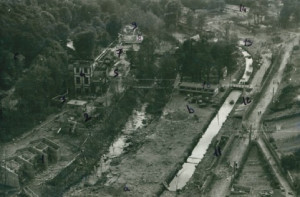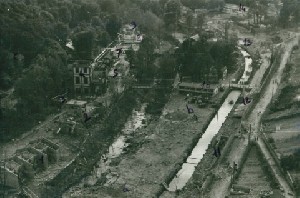Inside a powder factory, 2 series of explosions occurred at a 75-second interval around 1:15 pm, killing 3 and injuring 81 (60 employees, 20 nearby residents), 2 of whom in critical condition.
When the forklift operator for Building 211 (intermediate storage of dry powder) deposited a box of powder and removed his loading vehicle, fire broke out below and in back of the box (likely as a result of powder traces on the ground). All of Building 211’s boxes detonated almost simultaneously. The spray of hot debris ignited boxes loaded with powder soaked in solvent on the outdoor storage zone located in the vicinity as well as 4 adjacent buildings. The powder burned to a nominal extent and caused, due to the relay effect, fire to break out on 4 dry powder boxes placed temporarily alongside Dryer 314, at a distance of 100 m. Five seconds later, these boxes deflagrated and wound up detonating. The same process repeated itself from one set of boxes either dry or being dried to the next within a span of 8 or 9 seconds both inside and in front of Dryers 314 through 319; in all, 12 tonnes of powder detonated.
Property damage was considerable. All powder factory buildings sustained damage to varying degrees: window panes, roofs, suspended ceilings, etc. A great number of projections and shattered objects were found, including pieces of reinforced concrete, forklift debris and powder boxes. A 30-kg section of forklift was located over 200 m from the blast site; the forks though were never recovered. The former building sites were replaced by craters. 2/3 of the workforce was made redundant. Outside the site, 90 single-family homes were completely destroyed (walls and roofs collapsed), and 300-400 additional dwellings were partially destroyed (50%-80%).
Site reconstruction relied on both an alternative layout in order to make better use of space and organisational modifications. For each production line, a safety diagram was established, indicating for each phase the production step, intermediate storage, raw materials and end products deposited, manufacturing and transport operations, quantities of materials introduced, number of staff present, type of risks exposed, appropriate set of prevention and protection measures, predictable consequences of an accident and corresponding measures adopted. Subsequently, these improvements were made mandatory as regulations evolved.
This accident served to define the notion of critical explosion height for powders as well as the heretofore unknown phenomenon of combustion-detonation transition.
During the trial, the Court’s Chief Justice pointed out that the operator had sacrificed on safety in order to meet production targets.
Download the detailed report in .pdf format (346 Kb)





